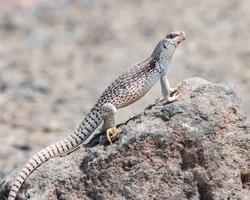Description[]
The Desert iguana is one of the most common lizards of the Sonoran and Mojave deserts of the southwestern United States and northwestern Mexico. It is pale gray-tan to cream in color with a light brown reticulated pattern on its back and sides. Down the center of the back is a row of slightly-enlarged, keeled dorsal scales that become slightly larger as you move down the back. The reticulated pattern gives way to brown spots near the back legs, turning into stripes along the tail. The belly is pale. During the breeding season, the sides become pinkish in both sexes.
Distribution[]
Desert iguanas are found in the southwestern United States and northwestern Mexico. They also occur on several Gulf of California islands. Their preferred habitat is largely contained within the range of the creosote bush, mainly dry, sandy desert scrubland and they can also be found in rocky streambeds. In the southern portion of their range, these lizards live in areas of arid subtropical scrub and tropical deciduous forest.
Continents[]
North America
Countries[]
United States, Mexico
Regions[]
Arizona, Utah, California, Nevada, Baja California
Biogeographical Realms[]
Nearctic
Biome[]
Desert, Forest, Grassland, Shurbland, Rocky areas
Climate Zones[]
Tropical, Arid, Temperate
Habits and Lifestyle[]
Desert iguanas are solitary creatures that are most active during hot midday hours. These lizards can withstand high temperatures and are out and about after other lizards have hidden into their burrows. Desert iguanas burrow extensively and if threatened will scamper into a shrub and go quickly down a burrow. Their burrows are usually dug in the sand under bushes like the creosote. They also often use burrows of other animals such as kit foxes and desert tortoises. Although Desert iguanas are primarily terrestrial they are very skillful climbers and often climb into the branches of bushes in order to reach the yellow flowers of the creosote bush, their favorite food. During cold months these lizards retreat into their burrows for winter hibernation.
Diet and Nutrition[]
Desert iguanas are primarily herbivorous (folivores, frugivores). They eat buds, fruits, and leaves of many plants and will occasionally consume insects and carrion.
Mating Habits[]
Desert iguanas are polygynous meaning that one male mates with more than one female. Breeding takes place in the early spring. It is believed that only one clutch of eggs is laid each year, with each clutch having 3-8 eggs. The hatchlings usually emerge around September; they are fully developed at birth and are able to fend for themselves. They will reach reproductive maturity and start to breed at 31-33 months of age.
Population[]
Population threats[]
Desert iguanas don't face any major threats present, however, locally some populations suffer from habitat destruction, mortality on highways, and climate changes.
Population number[]
According to the IUCN Red List, the total population size of Desert iguanas probably exceeds 100,000 mature individuals. Currently, this species is classified as Least Concern (LC) on the IUCN Red List.
